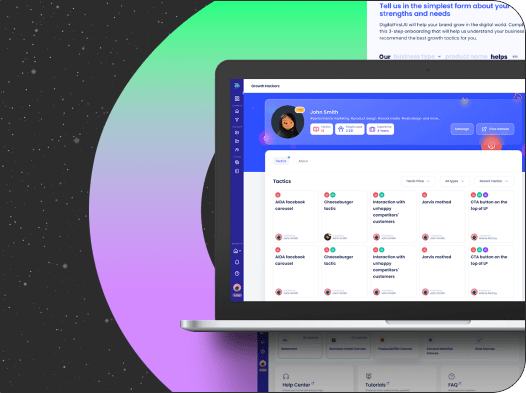AI Software
Development
If you’re looking for something more than just slapping “AI” label on your software product you’ve found the right place.
We were solving problems with AI Development Services for both international enterprises like BNP Paribas or Danone as well as for medium-sized companies and startups.
Thanks to our great experience in AI software projects we’ve even developed our own, unique approach that we’re evangelizing the industry with: Rapid AI Development Sprint = RAIDS.
Get estimate
We were solving problems with AI Development Services for both international enterprises like BNP Paribas or Danone as well as for medium-sized companies and startups.
Thanks to our great experience in AI software projects we’ve even developed our own, unique approach that we’re evangelizing the industry with: Rapid AI Development Sprint = RAIDS.
Rapid AI Development Sprint?
The Rapid AI Development Sprint is an accelerated program designed to help organizations leverage AI technologies effectively and efficiently.
The sprint unfolds over three weeks, starting with a discovery and analysis phase, followed by a design and prototyping phase, and culminating in the delivery of a proof of concept. The team is composed of an AI Consultant, Developers, and Quality Assurance professionals.
Overall, the Rapid AI Development Sprint is a focused, time-boxed approach to AI development that allows clients to quickly evaluate the potential impact of AI solutions on their business.


Why iterative, rapid
approach to AI is
the right one?
We come up with this approach as a response to the current AI wave that is making most of businesses eager to exploit new technology to create more value and be more competitive.

The Makers - most entrepreneurial and innovative people in companies are already coming up with ideas to use GPT and large language models. Our AI Dev Sprint allows them to get to the results and proof of concepts fast and set the path for AI adoption in their companies.
Benefits of fast AI software
development Sprint
A fast AI/GPT development sprint offers several benefits to the client, making it an attractive approach for organizations looking to leverage AI technologies in their business processes. Some key benefits include:
of the Rapid AI Development Sprint
Week 1
Sprint Discovery and Analysis
• Understand the client’s business and requirements
• Define the scope and goals of the sprint
• Identify potential AI use cases and opportunities
• Map out client’s business processes
• Determine high-impact areas for AI intervention
• Select the most suitable AI technologies (e.g., large language models, audio transcriptions, etc.)
• Develop a project roadmap and timeline
Week 2
Sprint Design and Prototyping
• Allocate resources and set expectations
• Rapid prototyping and testing Design and develop AI-driven solution components
• Iterate on client feedback and adjust the solution as needed
• Weekly status update and review with the client
• Share progress and insights
• Adjust the project scope and roadmap if needed
Week 3
Sprint Proof of Concept and Demonstration
• Integrate AI components and ensure functionality
• Test and validate the solution against client requirements
• Prepare and deliver a solution demonstration
• Showcase the proof of concept in a live environment
• Highlight the benefits and improvements to the client's business processes
• Final review and feedback session with the client
• Discuss the results of the sprint
• Identify potential areas for further development or iteration
Week 1
Sprint Discovery and Analysis
Week 2
Sprint Design and Prototyping
Week 3
Sprint Proof of Concept and Demonstration
• Understand the client’s business and requirements
• Define the scope and goals of the sprint
• Identify potential AI use cases and opportunities
• Map out client’s business processes
• Determine high-impact areas for AI intervention
• Select the most suitable AI technologies (e.g., large language models, audio transcriptions, etc.)
• Develop a project roadmap and timeline
• Allocate resources and set expectations
• Rapid prototyping and testing Design and develop AI-driven solution components
• Iterate on client feedback and adjust the solution as needed
• Weekly status update and review with the client
• Share progress and insights
• Adjust the project scope and roadmap if needed
• Integrate AI components and ensure functionality
• Test and validate the solution against client requirements
• Prepare and deliver a solution demonstration
• Showcase the proof of concept in a live environment
• Highlight the benefits and improvements to the client's business processes
• Final review and feedback session with the client
• Discuss the results of the sprint
• Identify potential areas for further development or iteration

• Outline key findings, insights, and deliverables
• Include recommendations for future development
• Schedule follow-up meetings and consultations to discuss the next steps
• Discuss potential for additional sprints or full-scale implementation
• Address any concerns or questions the client may have
The material results of an AI development sprint typically include several tangible deliverables and outcomes that demonstrate the value and potential of the AI-driven solution. The most important one is PoC itself.
The proof of concept is a crucial material result of the AI development sprint. It serves as a tangible representation of the AI-driven solution’s core functionalities, allowing the client to experience and evaluate the solution firsthand. OUr proof of concept typically includes the following components:
proof of concept focuses on implementing the most critical features of the AI-driven solution, which directly address the client’s business needs and objectives. These core features should demonstrate the solution’s potential to automate processes, optimize performance, or solve specific problems.
The proof of concept integrates the developed AI models and algorithms, such as GPT and large language models, to showcase the effectiveness of AI in addressing the client’s requirements. This integration demonstrates the value of incorporating AI technologies in the client’s business processes.
Although the proof of concept may not have a polished user interface, it should still offer an intuitive and user-friendly experience to help the client understand how the solution works and how it can benefit their organization.
Proof of concept should be functional enough to provide the client with a clear understanding of the AI-driven solution’s capabilities. This demonstration enables the client to evaluate the solution in a realistic context and identify any potential gaps or areas for improvement.
Developed and fine-tuned AI models, such as GPT or other large language models, along with the associated code, data, and configurations.
Wireframes, mockups, and prototypes of the user interface, showcasing the usability and user experience of the solution.
The source code for the AI-driven solution, typically stored in a version control system (e.g., Git) for easy collaboration and future development.
Instructions and recommendations on how to deploy and integrate the AI-driven solution within the client’s existing systems and infrastructure.
A summary of the sprint, including any challenges encountered, areas of improvement, and potential next steps for further development or full-scale implementation of the AI-driven solution.
Client feedback on the developed solution, including any suggestions for refinement or potential future enhancements.
A proposed roadmap outlining the next steps for the project, such as additional sprints, full-scale development, or integration with other systems.
Team composition
for Artificial Intelligence development projects
In this streamlined team composition, the roles and responsibilities are as follows:

Chat GPT implementation
We have several TB of data. These are files of various types, some of them are actually text materials (in various forms, most often PDF, DOC, PPT, etc.), but by volume the largest part of the data is various types of programs, ISO images and various other files, including those specialized for the client’s industry. What all these files have in common is that there is no way to generate any material about them, and the only information we have about them is their name, with a full path in the directory tree.

The client is having trouble finding information in this thicket of data. He would like to be able to search both the content and look for specific files by their names (without worrying about typos, punctuation, etc.). For now, the solutions used by the client do not meet their expectations.
As part of our cooperation, we have done two separate projects:
of the project was to convert a sample of data (~45GB) into text form. Where we could, we extracted the text data, otherwise we saved the basic information about the file.
In addition, for a selected group of several dozen image files, the client provided descriptions, which we also included.
generating vectors for AI and connecting the language model.
indexing the data in ElasticSearch.
The first, based on AI, provided three search methods: by file names, in content and, finally, a substantive answer to the question asked was generated by the language model.
The second interface provided results for the same queries, based on ElasticSearch.
that in the simplest queries, the content searches by AI and ElasticSearch were very similar to each other.
However, the more complex the query we asked, the better the results AI achieved and the worse ElasticSearch did. The advantage of AI is that it „understands” the context and can find and process content that does not always clearly answer our question. In addition, we achieved fantastic search results by file names, resistant to various errors, typos, etc.
Finally, the language model was able to respond substantively to the questions we asked where ElasticSearch does not provide such functionality and gets lost in such tasks.
Cost estimate
of Rapid AI Development Sprint
AI Development Sprints for Digital First AI


Background

Challenge
The Sprint Process
Sprint 1
Product discovery and ideation
Duration: 4 days
Sprint 2
Designing the AI system
Duration: 12 days
Sprint 3
Testing and feedback
Duration: 6 days
Sprint 1
Product discovery and ideation
Sprint 2
Designing the AI system
Sprint 3
Testing and feedback
Duration: 4 days
Duration: 12 days
Duration: 6 days
Results

Examples of the jobs that can be fulfilled by your next AI-supported solution. Focus on Large Language Models
01
Sentiment anaysis
02
Data indexing
03
Elevating bot's capabilities
04
Integrations
05
Detailed tasks
06
Efficient data extraction
07
Complex workflow facilitation
08
Accessibility Improvement
Develtio’s GPT-based chatbot

Capabilities
Examplres of questions You can ask
- Tell me about your product discovery process
- What will be the team's composition for the crowfunding platform development project?
- What is your tech stack?

Develtio’s GPT-based chatbot
Capabilities

Examplres of questions You can ask
- Tell me about your product discovery process
- What will be the team's composition for the crowfunding platform development project?
- What is your tech stack?






 Automate property listing data input and categorization
Automate property listing data input and categorization


